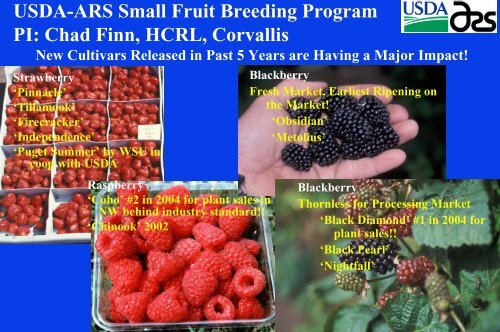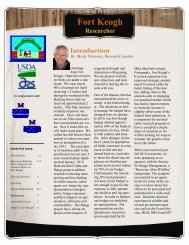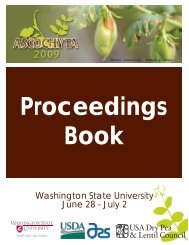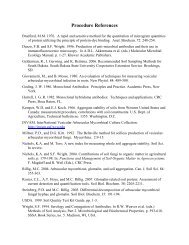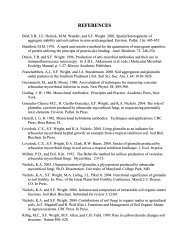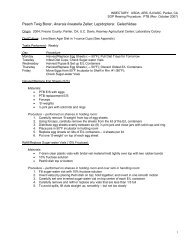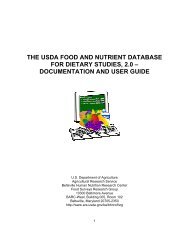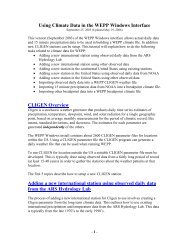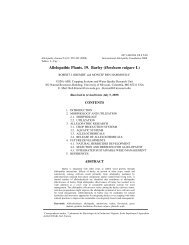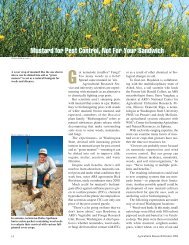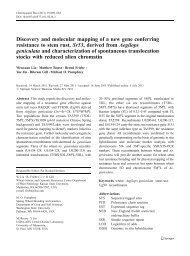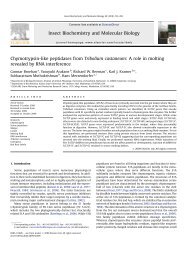Strawberry Cultivars for the West Coast
Strawberry Cultivars for the West Coast
Strawberry Cultivars for the West Coast
You also want an ePaper? Increase the reach of your titles
YUMPU automatically turns print PDFs into web optimized ePapers that Google loves.
USDA-ARS Small Fruit Breeding Program<br />
PI: Chad Finn, HCRL, Corvallis<br />
New <strong>Cultivars</strong> Released in Past 5 Years are Having a Major Impact!<br />
<strong>Strawberry</strong><br />
‘Pinnacle’<br />
‘Tillamook’<br />
‘Firecracker’<br />
‘Independence’<br />
‘Puget Summer’ by WSU in<br />
coop with USDA<br />
Raspberry<br />
‘Coho’ #2 in 2004 <strong>for</strong> plant sales in<br />
NW behind industry standard!!<br />
‘Chinook’ 2002<br />
Blackberry<br />
Fresh Market, Earliest Ripening on<br />
<strong>the</strong> Market!<br />
‘Obsidian’<br />
‘Metolius’<br />
Blackberry<br />
Thornless <strong>for</strong> Processing Market<br />
‘Black Diamond’ #1 in 2004 <strong>for</strong><br />
plant sales!!<br />
‘Black Pearl’<br />
‘Nightfall’
Small Fruit Horticulturist<br />
PI: David Bryla, HCRL, Corvallis<br />
New irrigation methods developed at<br />
<strong>the</strong> HCRU increase plant growth and<br />
improve water use efficiency in young<br />
blueberry fields; additional strategies<br />
are being developed <strong>for</strong> o<strong>the</strong>r berry<br />
crops grown in <strong>the</strong> region.
Plant Physiology – Nursery Crops<br />
PI: Carolyn Scagel, HCRL, Corvallis<br />
Defoliant 3% Urea + Defoliant<br />
Using foliar<br />
fertilization to<br />
increase<br />
transplant<br />
per<strong>for</strong>mance of<br />
bareroot<br />
nursery stock
Root Physiology, Grapevines and Small Fruits<br />
PI: Paul Schreiner, HCRL, Corvallis, OR<br />
This research focuses is on <strong>the</strong> nutritional requirements of grapevines<br />
and <strong>the</strong> factors that control root and mycorrhiza function (growth, nutrient<br />
and water uptake, nutrient storage) in small fruit production systems.<br />
Defining Optimal Nutrients<br />
<strong>for</strong> Pinot noir<br />
Use of Rhizoboxes in<br />
Vineyards
Grape Horiculturist<br />
PI: Julie Tarara, HCRL, Prosser, WA<br />
Effect of Temperature on Vine<br />
Physiology<br />
Measuring Wholevine<br />
Photosyn<strong>the</strong>sis
Grape Horticulturist<br />
PI: Krista Shellie, HCRL, Parma, ID<br />
Uneven Ripening<br />
Berry Temperature
Food Technology – Factors in wine quality<br />
PI: Jungmin Lee, HCRL, Parma, ID<br />
This is a new research program with <strong>the</strong> goal is to identify and apply<br />
factors that improve <strong>the</strong> color, aroma, and flavor of wine, from <strong>the</strong><br />
starting material to <strong>the</strong> end product.<br />
Pomace<br />
pH 3.5 pH 4.5 pH 7.0<br />
Grape extract
Where do Idaho grapes and wines stand?<br />
Biochemical component<br />
analysis of commercially<br />
available Idaho wines.<br />
2 reds and 2 whites (Merlot,<br />
Cabernet Sauvignon,<br />
Chardonnay, and Riesling).
Current project 2004<br />
Seed removal at different stages of fermentation- Merlot<br />
Control<br />
(CSR10)<br />
Skins present<br />
Seeds present<br />
12 days maceration<br />
Samples collected: grapes, must, seeds, finished wine<br />
Seeds removed<br />
@ 10.0°Brix<br />
(TSR10)
Nursery Crops Entomology,<br />
PI: Denny Bruck, HCRL, Corvallis<br />
1. Adult Black Vine<br />
Weevil (BVW)<br />
2. New Species of<br />
Microsporidian<br />
Parasite of BVW<br />
3. BVW Larvae<br />
infected with<br />
Metarhizium<br />
4. Metarhizium isolate<br />
that colonizes<br />
spruce roots and<br />
efficiently infects<br />
BVW larvae.
Infection Risk Model - Hop Powdery Mildew<br />
PI: Walt Mahaffee, HCRL, Corvallis<br />
Forecast Accuracy<br />
Day 1 Day 2 Day 3 Day 4 Day 5<br />
75% 68% 61% 58% 54%
Nematology Program<br />
PI: John Pinkerton, HCRL, Corvallis<br />
Tomato Ringspot (ToRSV)<br />
Infected Raspberries<br />
Cover Crop Trials<br />
After 3 years, cover crops were<br />
as effective as methyl bromide<br />
in reducing ToRSV<br />
Raised bed<br />
nonsolarized<br />
Solarization setup<br />
Raised bed<br />
solarized
Biology and Control Soil-Borne Pathogens<br />
PI: Robert Linderman, HCRL, Corvallis<br />
Papay<br />
- +<br />
Meadowfoam Seedmeal<br />
Geraniu<br />
- +<br />
Arbuscular Mycorrhizae<br />
Control of Phytophthora<br />
ramorum on Rhododendron<br />
Subdue Maxx<br />
+ -
Genetics of <strong>the</strong> Sudden Oak Death Pathogen<br />
PI: Nik Grunwald, HCRL, Corvallis<br />
• We found 2,128 and 1,000<br />
microsatellite loci in P.<br />
sojae and P. ramorum,<br />
respectively<br />
• Density of SSRs (bp per<br />
Mb) in P. sojae is about 1.5<br />
times that of P. ramorum.<br />
• Microsatellite loci are most<br />
useful molecular markers<br />
currently used to track<br />
spread of SOD and to<br />
understand <strong>the</strong> evolution<br />
and genetics of <strong>the</strong> genus<br />
Phytophthora<br />
Asexual<br />
reproductive<br />
structure of<br />
P. ramorum<br />
P. ramorum on<br />
rhododendron
Molecular Analysis of Biological Control<br />
of Plant Disease<br />
PI: Joyce Loper, HCRL, Corvallis<br />
Pseudomonas fluorescens Pf-5<br />
suppresses soilborne plant<br />
pathogens<br />
Untreated seeds<br />
Seeds treated<br />
with Pf-5<br />
Pf-5 is <strong>the</strong> first biological control agent<br />
<strong>for</strong> plant disease<br />
whose genomic sequence is known<br />
C<br />
H 3<br />
Anti-fungal antibiotics<br />
produced<br />
By Pf-5<br />
Cl<br />
O O<br />
OH<br />
HO<br />
NO 2<br />
N<br />
H<br />
OH<br />
Cl<br />
OH<br />
CH 3<br />
OH<br />
O<br />
N<br />
H<br />
Cl<br />
Cl
Small Fruit Virology Program<br />
PI: Robert Martin, HCRL, Corvallis<br />
Blueberry<br />
Virus<br />
Fruit Drop a new<br />
Virus Disease<br />
<strong>Strawberry</strong>-WA<br />
Decline caused by<br />
four aphid transmitted<br />
viruses<br />
Blackberry yellows<br />
New Crinivirus plus three<br />
o<strong>the</strong>r new Rubus viruses<br />
<strong>Strawberry</strong>- CA<br />
Decline caused by white<br />
fly and aphid transmitted<br />
viruses<br />
Control<br />
Engineered Resistance<br />
to RBDV<br />
Vector Control and Testing


